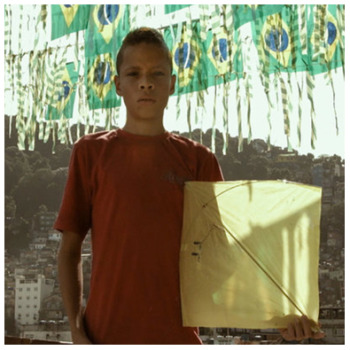Brazilian Kites Highlighted During 2014 World Cup
As the world's focus turned to Brazil in June and July of 2014 for the World Cup, attention was also brought to everyday life in Brazil.
 The New York Times published regular feature stories on aspects of life in Brazil. Often these stories showed the wide discrepancy of living conditions in the diverse economic conditions of the nation's largest cities.
The New York Times published regular feature stories on aspects of life in Brazil. Often these stories showed the wide discrepancy of living conditions in the diverse economic conditions of the nation's largest cities.
In a July 15, 2014 article entitled Kite Fight, correspondent Guillerme Tensol wrote about the passion that young Brazilians have for making, flying and fighting kites over the rooftops of their homes.
"After futebol, kite fighting is one of Brazil’s most popular sports. In the crowded urban favelas, flying a kite (or pipa) is more than a leisurely escape from harsh living conditions; it’s also a form of battle, with the sky an arena."
The Brazillian Pipa (kite) resembles a typical Indian fighter kite, or patang, in both shape and general dimensions. The frame is also similar to that of an Indian fighter kite.
Besides making the kites themselves, the young kite builders pound glass shards into a fine powder, wax their line and add the powdered glass to coat it. The complete kite fighting system is totally manufactured by the young builders using either paper or plastic shopping bags for the kite sails. For kite line reels a tin can is used to carefully wind the fighting line when the kite is not in flight. All materials are easily gathered from repurposed items that are readily or cheaply available.
 In addition to the brief article in The Times, a wonderful video documentary was produced about the Pipa, the kite fighting culture, and the skilled young artisans who craft their own kites.
In addition to the brief article in The Times, a wonderful video documentary was produced about the Pipa, the kite fighting culture, and the skilled young artisans who craft their own kites.
The video (linked here for viewing) is a compelling overview of life in Rocinha, Rio de Janeiro’s largest economically depressed community.
The simple beauty of kite construction and the skill of the kite fighters is beautifully captured in the video collaboration between the sports magazine Victory and the Brazilian production company Mosquito Project.
_____________
Note: See references to this article for attribution to source materials used. Copyright is held by The New York Times. The use of the materials in this post is intended to bring the information to a wider audience and educate readers about the use of kites in Brazil.
References (1)
-
 Source: Kite Fight
Source: Kite Fight






Reader Comments